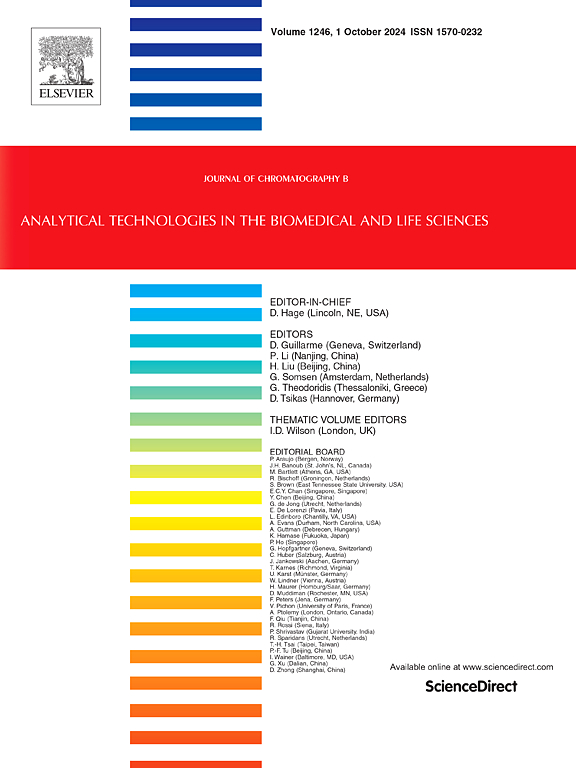Simultaneous determination of Favipiravir and its active metabolite, Favipiravir Ribofuranosyl-5′-triphosphate, in plasma and buccal cells using HPLC
IF 2.8
3区 医学
Q2 BIOCHEMICAL RESEARCH METHODS
引用次数: 0
Abstract
Favipiravir, recently approved for the treatment of tickborne severe fever with thrombocytopenia syndrome, is a prodrug that can be metabolized in vivo into its active phosphorylated form. Given that the accurate pharmacokinetic analysis of favipiravir and its active metabolite is crucial for dosage adjustment and, hence, therapeutic efficacy optimization, we herein developed an HPLC–based method for the simultaneous quantification of favipiravir and its active metabolite in plasma and buccal cells. Separation within 17 min was achieved using a mixed-mode C18 column with an anion-exchange functionality as the stationary phase, a phosphate buffer (pH 6.38) as the mobile phase, and gentisic acid as the internal standard. Fluorescence-based detection (excitation/emission = 370/440 nm) enabled the quantification of both compounds within the therapeutic range of 10–500 μM without interference from endogenous biological substances. The developed method, which allows for the rapid and reliable simultaneous determination of the prodrug and its active metabolite, is expected to be useful for improving the therapeutic outcome of favipiravir while minimizing side effects.
同时测定血浆和颊细胞中Favipiravir及其活性代谢物Favipiravir核糖呋喃基-5 ' -三磷酸
Favipiravir最近被批准用于治疗蜱传重症发热伴血小板减少综合征,是一种可在体内代谢成活性磷酸化形式的前药。鉴于准确的favipiravir及其活性代谢物的药代动力学分析对剂量调整和疗效优化至关重要,本研究建立了一种基于高效液相色谱的同时定量血浆和颊细胞中favipiravir及其活性代谢物的方法。采用具有阴离子交换功能的混合模式C18色谱柱,固定相为磷酸缓冲液(pH 6.38),内标物为龙胆酸,在17 min内分离。基于荧光的检测(激发/发射= 370/440 nm)能够在10-500 μM的治疗范围内对两种化合物进行定量,而不受内源性生物物质的干扰。该方法可以快速、可靠地同时测定前药及其活性代谢物,有望改善favipiravir的治疗效果,同时最大限度地减少副作用。
本文章由计算机程序翻译,如有差异,请以英文原文为准。
求助全文
约1分钟内获得全文
求助全文
来源期刊

Journal of Chromatography B
医学-分析化学
CiteScore
5.60
自引率
3.30%
发文量
306
审稿时长
44 days
期刊介绍:
The Journal of Chromatography B publishes papers on developments in separation science relevant to biology and biomedical research including both fundamental advances and applications. Analytical techniques which may be considered include the various facets of chromatography, electrophoresis and related methods, affinity and immunoaffinity-based methodologies, hyphenated and other multi-dimensional techniques, and microanalytical approaches. The journal also considers articles reporting developments in sample preparation, detection techniques including mass spectrometry, and data handling and analysis.
Developments related to preparative separations for the isolation and purification of components of biological systems may be published, including chromatographic and electrophoretic methods, affinity separations, field flow fractionation and other preparative approaches.
Applications to the analysis of biological systems and samples will be considered when the analytical science contains a significant element of novelty, e.g. a new approach to the separation of a compound, novel combination of analytical techniques, or significantly improved analytical performance.
 求助内容:
求助内容: 应助结果提醒方式:
应助结果提醒方式:


